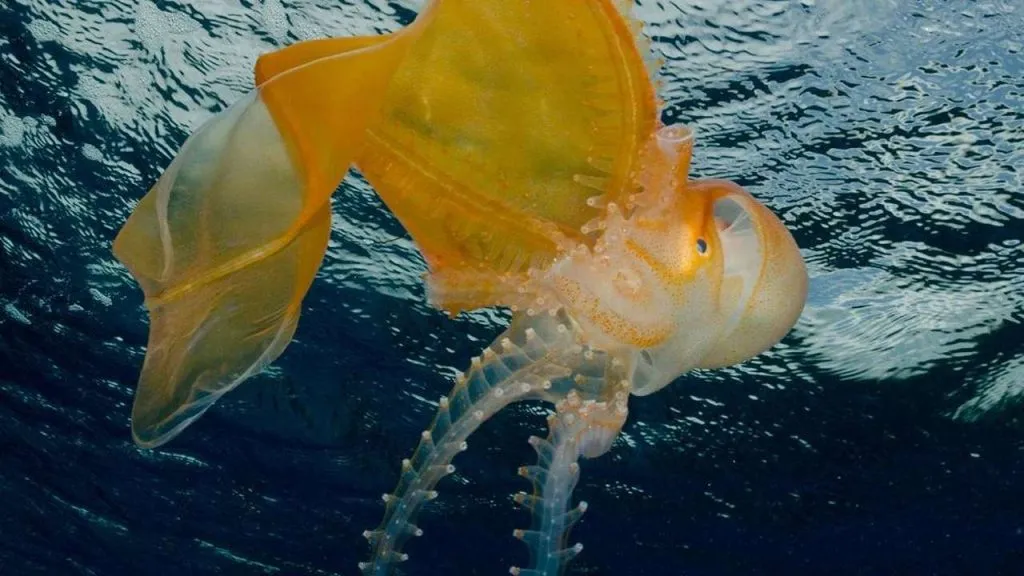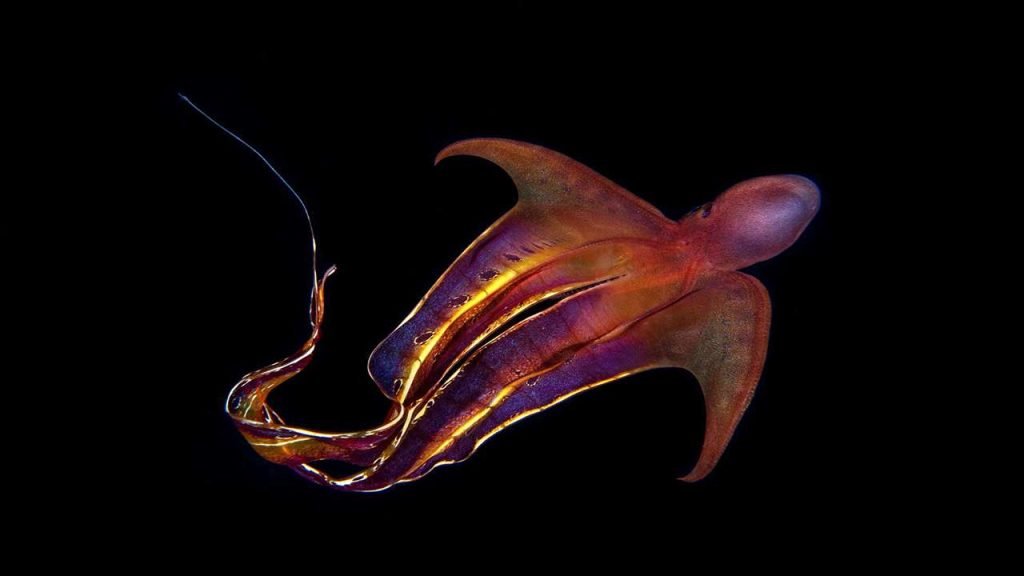As an Amazon Associate I earn from qualifying purchases.
Blanket octopuses belong to a group of octopuses that live in deep ocean waters. Most of them are around 20 cm (8 in) long, but some can grow up to 50 cm (20 in).
They have a special webbing between their third and fourth pairs of arms, which is often longer than their bodies.
Additionally, they lack pigment cells, which makes them look pale overall. These unique features distinguish them from other octopus species.
They live in tropical to temperate waters all over the world, usually at depths of over 1,000 m (3,300 ft).
They’re among the deepest-living octopuses known, and one individual was even found at a depth of 7,000 m (23,000 ft).
Living so deep means they’re exposed to high pressures, and they struggle to adjust when brought up to the surface.
Their diet mainly consists of shrimp, crabs, and other small crustaceans, but they’ve been seen going after fish much bigger than themselves.
When it comes to reproducing, blanket octopuses lay eggs that hatch into tiny larvae floating in the ocean.
Eventually, these larvae settle on the ocean floor and change into adult octopuses.
The blanket octopus is quite remarkable due to its unique appearance and interesting behaviors.
In this blog post, we’ll delve into what blanket octopuses eat throughout the year, what baby blanket octopuses munch on, how they hunt, and share some intriguing facts about these captivating creatures.
What Do Blanket Octopuses Eat All Year-Round: List of Food They Love

Blanket octopuses are meat-eaters, meaning they mainly eat other animals.
They especially like to munch on small fish, but they also enjoy snacking on shrimp and other tiny creatures like krill, crab larvae, and small shellfish such as clams and snails.
These octopuses aren’t picky eaters; they’ll gobble up whatever they can catch!
They’re also pretty good at cracking open shells to get to the tasty insides of mollusks like clams and cuttlefish.
What’s interesting is that, unlike most other animals, blanket octopuses aren’t bothered by the stings of some jellyfish.
They happily eat these jelly-like creatures, along with other gelatinous organisms called salps.
Sometimes, if food is scarce or they’re feeling a bit peckish, blanket octopuses might even snack on smaller members of their kind or other cephalopods like squid and cuttlefish.
So, they’re not just hunters; they can be a bit cannibalistic too!
What Do Baby Blanket Octopuses Eat?
Just like grown-up blanket octopuses, baby ones also eat meat, mainly from small ocean creatures.
However, since they’re smaller and still growing, their food choices might be a bit different.
They go after really tiny creatures that give them the energy they need, like small floating animals called plankton and tiny shrimp and other shellfish.
Sometimes they also eat tiny crabs and larvae of small fish. They need this varied diet to grow quickly and stay healthy.
As they get bigger, they might start eating a wider range of foods, just like the adults do.
How Do Blanket Octopuses Hunt?
Blanket octopuses are clever hunters, and they have a neat trick up their sleeves when it comes to hunting: they’re not affected by the stings of jellyfish.
This is especially true for male and young female octopuses. What they do is pretty sneaky: they grab onto the tentacles of jellyfish, like the Portuguese Man O’ War, and then detach them using their beaks.
Afterward, they turn these tentacles into weapons. They swing them around like a whip, injecting their prey with the jellyfish venom.
This helps them catch smaller fish more easily because the venom stuns them.
Apart from this smart move, blanket octopuses also have other hunting tactics, like using their strong arms to grab prey or hiding in their surroundings to surprise their victims.
Where Do Blanket Octopuses Live: The Habitat of Blanket Octopuses
Blanket octopuses live deep down in the ocean, and they like warm, subtropical waters.
You can find them in lots of different places in the ocean, like near the shore or way out in the deep sea.
They’re not picky about where they hang out—they’re just as happy near coral reefs and rocky areas as they are out in the open ocean.
These octopuses are sneaky and like to hide around underwater structures, like coral reefs or kelp forests, to stay safe.
But they’re also brave enough to explore deeper waters where they hunt for food.
They’re pretty tough creatures and can live in all sorts of ocean environments, from warm tropical areas to cooler places.
So, whether it’s near the shore or deep down in the ocean, you might just come across a blanket octopus!

Facts About The Blanket Octopus
1. Big Size Difference: Blanket octopuses have a big gap in size between males and females.
Females can grow up to six feet long (around 2 meters), while males are way smaller, often less than an inch (just a few centimeters) in size.
2. Cool Defense Move: Female blanket octopuses have a neat trick to scare off predators.
When they feel threatened, they spread out their flowing membranes to look bigger and scarier to their attackers.
3. Jellyfish Immunity: Blanket octopuses, especially males and young females, can’t be hurt by the sting of certain jellyfish, like the Portuguese Man O’ War.
They even use the stinging tentacles of these jellyfish as weapons when hunting for food.
4. Amazing Hiding Skills: Just like other octopus species, blanket octopuses are experts at blending into their surroundings.
They can change the color and texture of their skin to match their environment perfectly, making them great at hunting and hiding from predators.
5. Puzzling Love Life: Scientists are still trying to figure out how blanket octopuses find mates.
Female blanket octopuses have been seen carrying eggs under their thin membranes, which look like floating blankets. That’s where their name comes from!
6. Short Lifespan: Blanket octopuses don’t live very long. Females usually only live for one to two years, which means they have to grow up and have babies quickly to keep their population going.
7. Ocean Explorers: While we often see blanket octopuses near the coast, they’re also brave enough to venture into deeper parts of the ocean.
They can go down more than 3,000 feet (over 1,000 meters) deep, showing just how adaptable they are to different environments.
These cool facts help us understand more about the blanket octopus and why it’s such an interesting creature in the deep sea.
Conclusion
To sum up, the way blanket octopuses eat and behave gives us a really interesting look at how things work in the ocean.
They have all sorts of favorite foods and cool hunting skills, which keep scientists and fans of the ocean amazed.
As we keep exploring the secrets of the deep sea, the blanket octopus shows us just how tough and flexible life can be under the water.
FAQ’s:
Blanket octopuses aren’t exactly common, but they’re not super rare either.
They’re often found in warm, tropical oceans, but they can be tricky to spot because they like to hide in deep waters.
Blanket octopuses are known to live at different depths in the ocean.
They can be found closer to the surface, especially at night, and they’re also capable of diving deep, down to about 4 miles (6.4 kilometers).
Yes, blanket octopuses do have eyes! Their eyes are pretty sharp, helping them to spot prey and navigate their environment in the deep ocean.
Yes, octopuses do sleep, but it’s a bit different from how humans sleep.
They might take short naps throughout the day and night, but they don’t have a regular sleep schedule like we do.
Unlike some other types of octopuses, blanket octopuses don’t have ink sacs.
Instead of using ink to escape from predators, they rely on other defense mechanisms, like their ability to change colour and shape to blend into their surroundings.
Amazon and the Amazon logo are trademarks of Amazon.com, Inc, or its affiliates.

